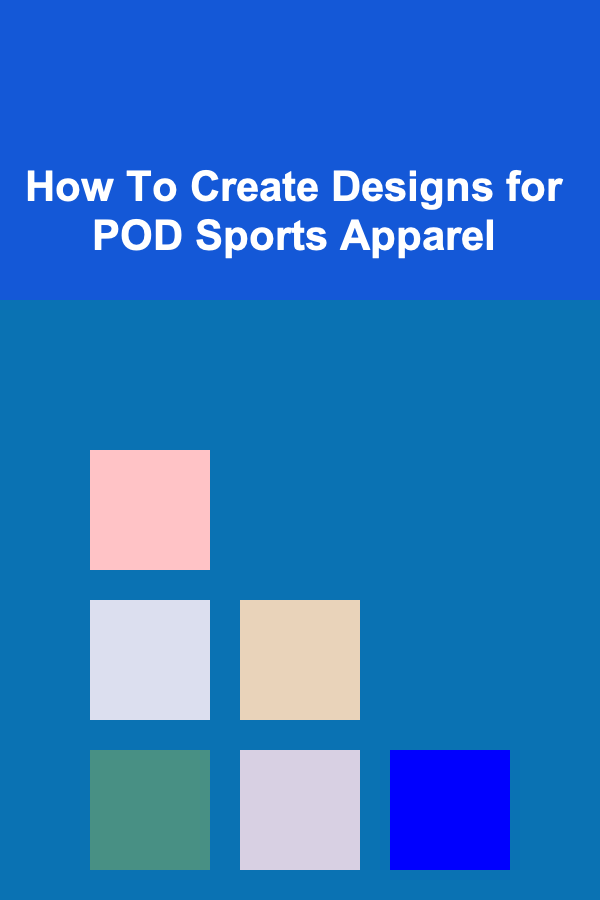
How To Create Designs for POD Sports Apparel
ebook include PDF & Audio bundle (Micro Guide)
$12.99$5.99
Limited Time Offer! Order within the next:

Print on Demand (POD) has become a popular business model in the world of fashion, especially for sports apparel. The process allows designers to create and sell custom products without holding inventory, which is both cost-effective and accessible to entrepreneurs of all levels. For sports apparel, the challenge lies not just in the technical aspect of design but in understanding the unique needs of sports enthusiasts, athletes, and teams.
In this article, we will guide you through the steps of creating compelling designs for POD sports apparel. From understanding the target market to mastering design techniques and choosing the right printing methods, we will explore everything you need to know to succeed in this niche.
Understanding the Market and Audience
Before diving into design, it's important to understand the target audience for sports apparel. Sports apparel designs cater to a wide variety of groups, each with their own unique preferences, needs, and motivations.
Key Demographics:
- Athletes: This group looks for high-performance apparel that supports their sport. They prefer designs that offer a mix of functionality, comfort, and style. Consider different sports such as running, cycling, football, basketball, or yoga when tailoring designs.
- Fans: Sports enthusiasts often wear apparel to show support for their favorite teams or athletes. Designs for this group typically feature team logos, mascots, colors, and slogans.
- Casual Wearers: This segment includes people who like the aesthetic of sports apparel but aren't necessarily athletes or fans. They may prefer simple, stylish designs or athleisure-inspired graphics.
- Fitness Community: People who engage in personal fitness or gym-related activities often look for athletic wear that's both practical and motivating. Inspirational quotes, gym culture references, and active lifestyle themes work well here.
Research the Competition:
To create designs that stand out, it's essential to research existing POD sports apparel offerings. Look for gaps in the market that your designs could fill. Platforms like Etsy, Redbubble, and Teespring provide insight into what sells well in the sports apparel category.
Design Principles for Sports Apparel
Sports apparel design is not just about aesthetics; it's also about function and fit. Understanding the principles of design will help ensure that your graphics work well on clothing, taking into consideration fabric types, cuts, and printing methods.
Keep It Simple and Bold
Sports apparel designs often thrive on simplicity. A clean and bold design tends to be more effective than something overly complicated. Think about iconic sports logos---often, they're just a few lines or shapes that can be easily recognized from a distance. For sports teams, simplicity is key in making sure the logo or name is visible from far away.
Use of Typography
For sports apparel, typography can play a significant role. Strong, legible fonts that make a statement are important for team names, motivational quotes, and sports slogans. Consider the sport when choosing the font style. For example, bold and aggressive fonts work well for football or rugby, while more dynamic or fluid fonts may be suited for sports like swimming or tennis.
Color Theory
Colors play a massive role in sports design. Different colors evoke different emotions and can convey specific messages. For example:
- Red: Power, passion, and energy. Common in team sports and martial arts.
- Blue: Calm, stability, and trust. Popular in cycling and running apparel.
- Black and White: Timeless and versatile. Often used for minimalist designs or for sports teams.
- Bright Colors (Yellow, Orange): Energizing and eye-catching. Great for fitness wear and running apparel.
Tools and Software for Designing Sports Apparel
Once you have a concept in mind, you'll need the right tools to bring your ideas to life. Many designers use a variety of software depending on their skill level and specific needs.
Adobe Illustrator
Illustrator is a vector-based design tool that is the industry standard for creating professional apparel designs. The key advantage of using Illustrator for POD apparel design is that vector files (such as .ai or .eps) can be resized without losing quality, which is essential for ensuring your design looks sharp on different sizes of apparel.
Adobe Photoshop
Photoshop is primarily used for working with raster images, making it useful for designs that involve intricate details or photographic elements. However, for POD apparel, you may need to be cautious about resolution. Ensure your images are at least 300 DPI for high-quality printing.
Canva
Canva is an easy-to-use design tool that is especially beneficial for beginners. It has pre-made templates and drag-and-drop functionality that can help you create designs quickly, though it is less powerful than Adobe's offerings. You can use it for creating simple designs, adding text overlays, or even manipulating pre-made sports-themed images.
Affinity Designer
Affinity Designer is a popular alternative to Adobe Illustrator, known for its user-friendly interface and powerful design features. It's a great option for those who need vector design tools without the subscription fees that Adobe charges.
Procreate
For designers using an iPad, Procreate offers a fantastic platform for digital drawing. It's ideal for sketching, hand-drawn logos, and other custom elements that can be incorporated into sports apparel designs.
Incorporating Popular Trends in Sports Apparel Design
Keeping up with design trends in the sports apparel industry can give you an edge in creating relevant and appealing products. Some current design trends include:
Minimalist Designs
Minimalism continues to dominate many fashion industries, including sports apparel. Simple designs with clean lines, muted colors, and subtle branding appeal to consumers who prefer a more understated aesthetic.
Vintage and Retro Graphics
There's a growing trend toward vintage and retro designs, especially for teams and brands that have been around for a long time. Classic sports graphics, like old-school team logos, retro typography, or vintage-style sportswear, have made a huge comeback.
Customization
Customization is key in the POD model. Sports fans love personalized apparel that features their name, number, or favorite athlete's jersey number. Providing options for customers to customize their sports apparel with their name or team affiliation adds a personal touch that enhances the value of your designs.
Motivational Quotes
Athletes and fitness enthusiasts often seek motivation, and apparel with motivational quotes and phrases resonate with them. Designs that include phrases like "Train Hard," "Never Give Up," or "Push Your Limits" are popular and effective in the fitness market.
Printing Methods for Sports Apparel
Once your designs are ready, it's time to think about the printing process. The method you choose can significantly impact the quality, feel, and durability of the apparel.
Screen Printing
Screen printing is one of the most popular methods for printing on sports apparel, especially for bulk orders. It works well for simple designs with few colors and offers high durability. The downside is that it's not ideal for highly detailed or full-color designs.
Direct to Garment (DTG)
DTG printing is a great option for smaller runs of apparel, as it allows for full-color prints with no minimum order. It's suitable for intricate designs and photographs, making it perfect for detailed sports logos and personalized prints. However, the printing can sometimes feel heavy on certain fabric types.
Sublimation Printing
Sublimation printing is perfect for polyester sportswear, as it uses heat to transfer dye into fabric fibers. It's ideal for all-over prints, vibrant colors, and designs that require full coverage. The downside is that it works best with light-colored fabrics and may not work as well on dark clothing.
Heat Transfer Vinyl (HTV)
HTV involves cutting designs out of vinyl and applying them to fabric using heat. This method is often used for custom names and numbers on jerseys. It's durable and works well on both light and dark fabrics, but it's best suited for designs with solid shapes and colors rather than detailed artwork.
Choosing the Right Sports Apparel for POD
The choice of apparel plays a crucial role in how your designs are received. For sportswear, you need to focus on fabric quality, functionality, and comfort.
- Athletic T-Shirts and Tanks: These are great for casual sports apparel, fitness, and workout gear. Look for moisture-wicking materials that enhance performance.
- Compression Gear: Compression shirts, leggings, and shorts are popular in sports like running, cycling, and weightlifting. They require designs that complement their form-fitting nature.
- Hoodies and Jackets: These are essential for athletes who need something warm after a workout or outdoor activity. Full zip designs and pullover styles work well with bold logos and team names.
- Sports Bras and Leggings: For female athletes, sports bras and leggings are must-have items in any sportswear line. These require thoughtful designs that support comfort and function.
- Team Jerseys: Jerseys are the cornerstone of sports apparel, and POD platforms often allow customization. These can feature numbers, logos, or team names and are designed for various sports.
Marketing Your Sports Apparel Designs
Once your designs are finalized and ready for sale, the next step is to market them effectively. Utilize social media platforms like Instagram, TikTok, and Facebook to showcase your designs. Collaborate with athletes, sports influencers, or fitness enthusiasts to get the word out about your products. Additionally, you can run ads targeted at specific sports communities, and create online stores where customers can personalize their designs.
Engage in SEO (Search Engine Optimization) to drive traffic to your POD store, and create content that resonates with your audience, such as fitness tips, athlete interviews, or sports-related content.
Conclusion
Creating designs for POD sports apparel is both a creative and strategic process. By understanding your audience, utilizing the right design tools, keeping up with trends, and selecting the right printing method, you can create sports apparel that resonates with athletes, fans, and fitness enthusiasts. As the POD model offers low-risk entry into the fashion world, it's a great opportunity for anyone looking to start a sportswear business with custom designs. Whether you're creating sleek, minimalist designs or bold, colorful sports graphics, the key is to offer high-quality products that your audience will love to wear.

How to Achieve Big Results While Saving Money on Home Remodeling Projects
Read More
How to Organize Memories for Easy Reflection Later
Read More
How to Prevent and Clean Grout Lines in Your Bathroom
Read More
How to Use a Recipe Box for Traditional Storage Methods
Read More
How To Craft Powerful Themes in Your Writing
Read More
How to Embroider Realistic Pet Portraits
Read MoreOther Products

How to Achieve Big Results While Saving Money on Home Remodeling Projects
Read More
How to Organize Memories for Easy Reflection Later
Read More
How to Prevent and Clean Grout Lines in Your Bathroom
Read More
How to Use a Recipe Box for Traditional Storage Methods
Read More
How To Craft Powerful Themes in Your Writing
Read More